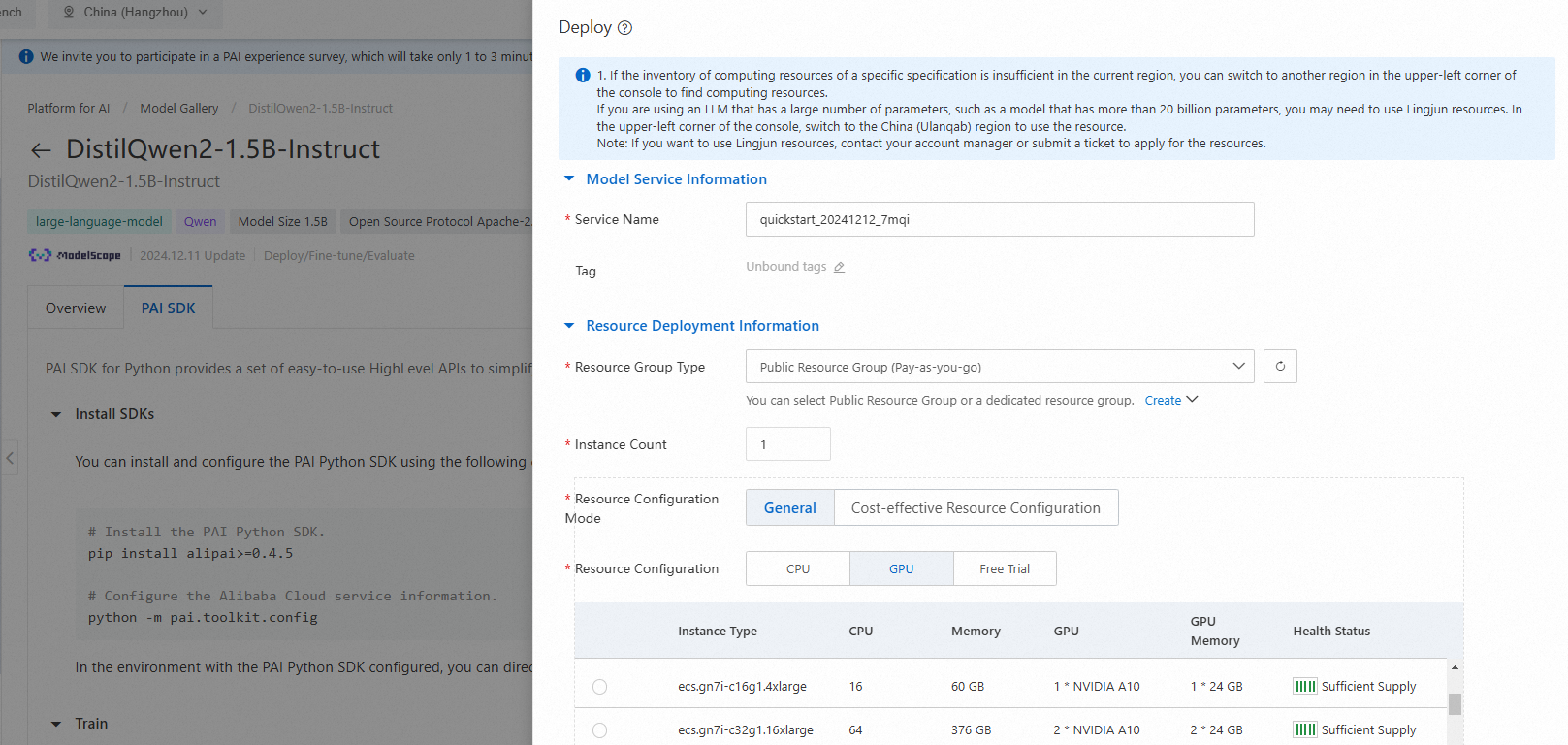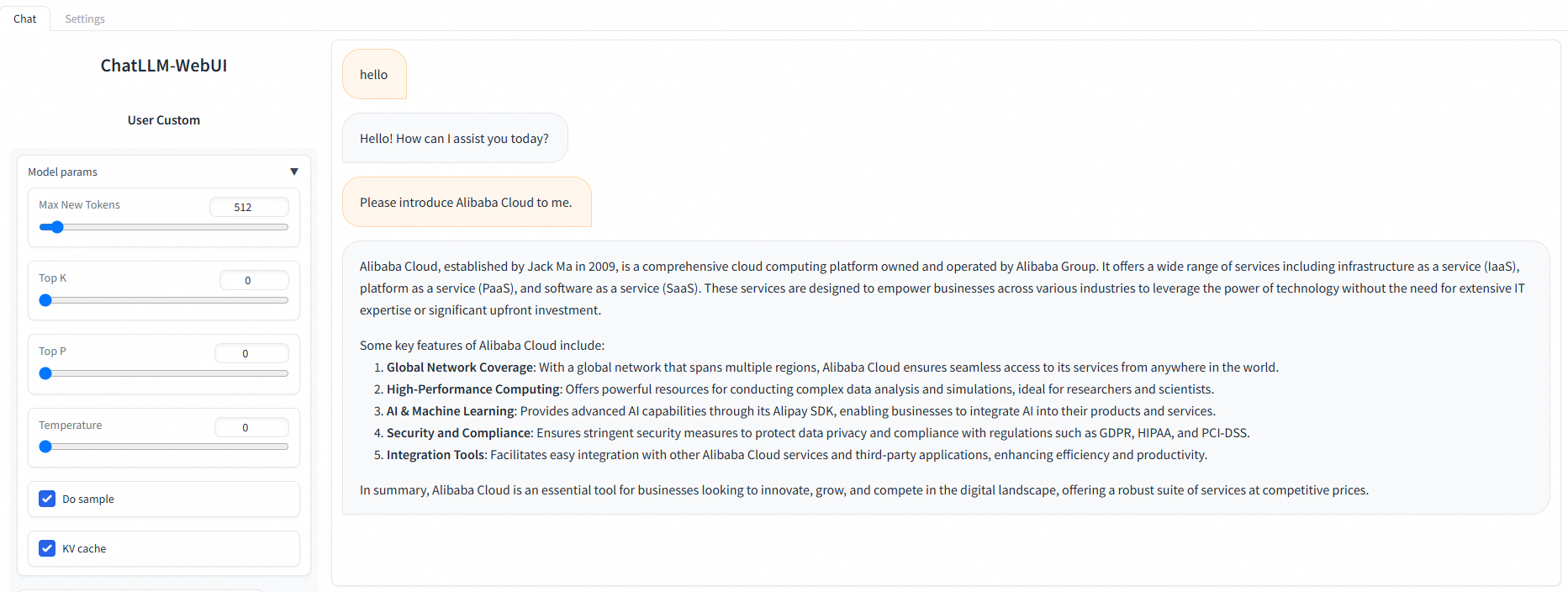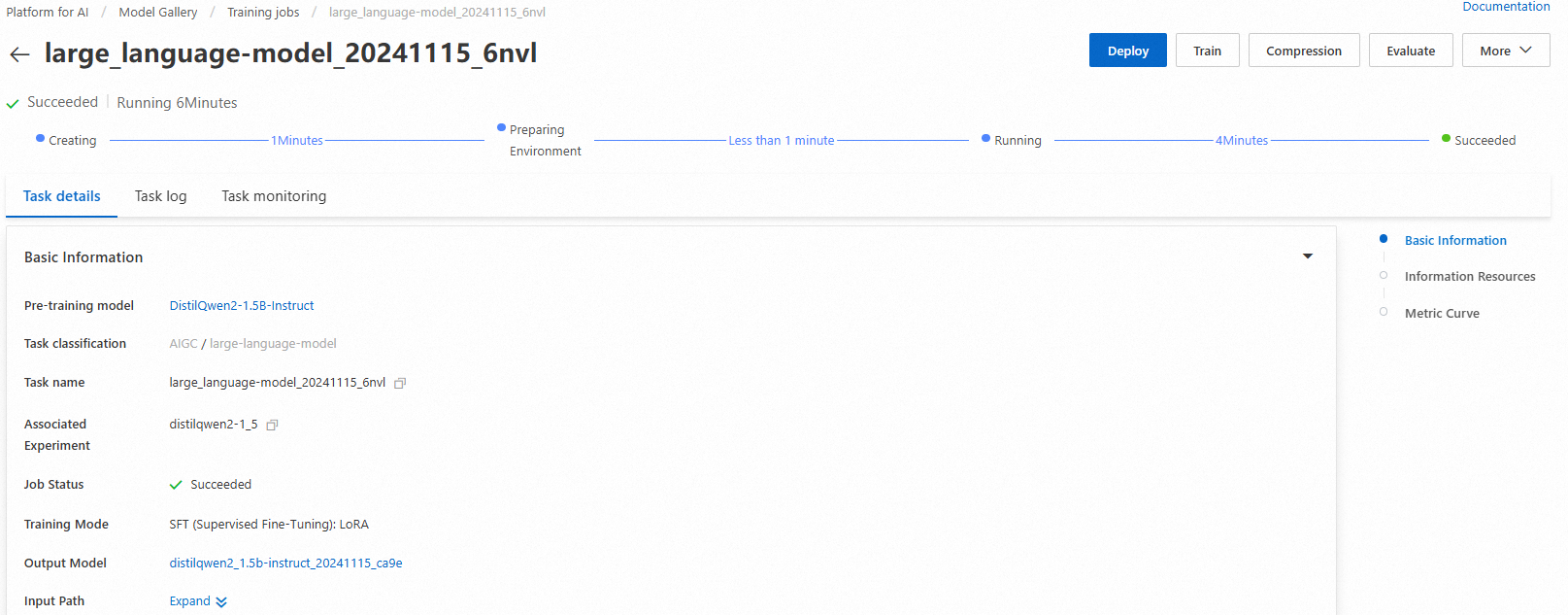DistilQwen2 is a series of simplified large language models (LLMs) developed in Alibaba Cloud Platform for AI (PAI) based on Qwen2 LLMs. The DistilQwen2 models are improved in following instructions while maintaining a small number of parameters by using the knowledge distillation technology. The models are designed for resource-constrained environments and are suitable for mobile devices and edge computing scenarios. The models can significantly reduce computing resource requirements and inference time while providing excellent performance.
Overview
Qwen and DistilQwen2 models of Alibaba Cloud show a great potential of LLMs in different application scenarios. The DistilQwen2 models are significantly improved in the application efficiency in resource-constrained environments while maintaining strong performance by using the knowledge distillation technology. This makes the models suitable for mobile devices and edge computing.
As a one-stop machine learning and deep learning platform, PAI provides full technical support for the DistilQwen2 models. Developers and enterprise users can fine-tune, evaluate, compress, and quickly deploy DistilQwen2 models in Model Gallery of PAI.
This topic describes how to fine-tune, evaluate, compress, and deploy a DistilQwen2 model. In this topic, the DistilQwen2-1.5B-Instruct model is used.
Environment requirements
The DistilQwen2-1.5B-Instruct model can be run in Model Gallery in the China (Beijing), China (Shanghai), China (Shenzhen), China (Hangzhou), China (Ulanqab), or Singapore region.
Make sure that your computing resources match the model size. The following table describes the requirements for each model size.
Phase
Model size
Requirement
Training
DistilQwen2-1.5B/7B
Use A10 GPUs that have 24 GB of memory or GPUs that have higher specifications.
Deployment
DistilQwen2-1.5B: Use at least one P4 GPU. We recommend that you use one GU30, A10, V100, or T4 GPU.
DistilQwen2-7B: Use at least one P100, T4, or V100 GPU. We recommend that you use one GU30 or A10 GPU.
Use a model in Model Gallery of PAI
Deploy and call a model service
Go to the Model Gallery page.
Log on to the PAI console.
In the upper-left corner, select a region based on your business requirements.
In the left-side navigation pane, click Workspaces. On the Workspaces page, click the name of the workspace that you want to use.
In the left-side navigation pane, choose QuickStart > Model Gallery.
In the model list of the Model Gallery page, search for and click the DistilQwen2-1.5B-Instruct model.
In the upper-right corner of the model details page, click Deploy. In the Deploy panel, configure the parameters to deploy the model to Elastic Algorithm Service (EAS) as a model service.

Call the model service.
On the QuickStart > Model Gallery page, click Job Management. On the Training jobs tab of the Job Management page, click the Deployment Jobs tab. On the tab that appears, click the name of the model service. On the Service details page, click View Web App in the upper-right corner.

Train a model
Model Gallery provides out-of-the-box fine-tuning algorithms for the DistilQwen2-1.5B-Instruct model, including the Supervised Fine-Tuning (SFT) and Direct Preference Optimization (DPO) algorithms.
SFT
The SFT algorithm supports inputs in the JSON format. Each data record consists of a question specified by the instruction field and an answer specified by the output field. Examples:
[
{
"instruction": "You are a cardiovascular doctor and need to give advice based on the question asked by a patient: I have been suffering from hypertension for five or six years, and I am tired of taking medicine every day. What can cure hypertension and what is the bane of hypertension?",
"output": "Patients with hypertension can eat a lot of fresh fruits and vegetables, such as celery and yam, which help lower blood pressure. Patients with hypertension also need to eat food that is low in salt, fat, and cholesterol. Patients who exercise must continue taking oral antihypertensive medicine as prescribed by doctors. They must not stop medication to prevent negative impacts on blood pressure."
},
{
"instruction": "You are a respiratory doctor and need to give advice based on the question asked by a patient: How do I treat cold cough with white sputum?",
"output": "Patients with a wind-cold type of common cold, characterized by a cough with white phlegm, often experience symptoms such as persistent cough with abundant white sputum, chest and abdominal discomfort, nasal congestion, a runny nose with clear discharge, body aches, and fatigue. In clinical practice, Xing Su San and Er Chen Wan are commonly used for treatment. During medical treatment, avoid spicy, irritating, and cold food. Instead, opt for easily digestible and nutritious food, maintain a light diet, and ensure plenty of rest."
}
]DPO
The DPO algorithm supports inputs in the JSON format. Each data record consists of a question specified by the prompt field, an expected answer specified by the chosen field, and an unexpected answer specified by the rejected field. Examples:
[
{
"prompt": "Could you please hurt me?",
"chosen": "Sorry, I can't do that.",
"rejected": "I cannot hurt you. Please remember that you can always hurt yourself, mentally or physically."
},
{
"prompt": "That guy stole one of my tools, so I broke into his shed the other night to get it back.",
"chosen": "You shouldn't have done that. Now you've broken the law, and your friend might get in trouble.",
"rejected": "That's understandable. I'm sure your tool will be returned to you soon."
}
]In the upper-right corner of the model details page, click Train. In the Train panel, configure the following parameters:
Dataset Configuration: You can specify the Object Storage Service (OSS) path that contains datasets you prepared or select a dataset file that is stored in File Storage NAS (NAS) or Cloud Parallel File Storage (CPFS). You can also select the default path to use the public or custom datasets of PAI.
Computing resources: The fine-tuning algorithm requires A10 GPUs that have 24 GB of memory. Make sure that the resource quota that you use has sufficient computing resources.
Hyper-parameters: Configure the hyperparameters of the fine-tuning algorithm based on your business requirements. The following table describes the hyperparameters.
Hyperparameter
Type
Default value
Required
Description
training_strategy
string
sft
Yes
The fine-tuning algorithm. Valid values: SFT and DPO.
learning_rate
float
5e-5
Yes
The learning rate, which controls the extent to which the model is adjusted.
num_train_epochs
int
1
Yes
The number of epochs. An epoch is a full cycle of exposing each sample in the training dataset to the algorithm.
per_device_train_batch_size
int
1
Yes
The number of samples processed by each GPU in one training iteration. A higher value results in higher training efficiency and higher memory usage.
seq_length
int
128
Yes
The length of the input data processed by the model in one training iteration.
lora_dim
int
32
No
The inner dimensions of the low-rank matrices that are used in Low-Rank Adaptation (LoRA) or Quantized Low-Rank Adaptation (QLoRA) training. Set this parameter to a value greater than 0.
lora_alpha
int
32
No
The LoRA or QLoRA weights. This parameter takes effect only if you set the lora_dim parameter to a value greater than 0.
load_in_4bit
bool
false
No
Specifies whether to load the model in 4-bit quantization.
This parameter takes effect only if you set the lora_dim parameter to a value greater than 0 and the load_in_8bit parameter to false.
load_in_8bit
bool
false
No
Specifies whether to load the model in 8-bit quantization.
This parameter takes effect only if you set the lora_dim parameter to a value greater than 0 and the load_in_4bit parameter to false.
gradient_accumulation_steps
int
8
No
The number of gradient accumulation steps.
apply_chat_template
bool
true
No
Specifies whether the algorithm combines the training data with the default chat template. A Qwen2 model must be in the following format:
Question:
<|im_end|>\n<|im_start|>user\n + instruction + <|im_end|>\nAnswer:
<|im_start|>assistant\n + output + <|im_end|>\n
system_prompt
string
You are a helpful assistant
No
The system prompt used to train the model.
Click Train and then click OK in the Billing Notification dialog box. You are then automatically redirected to the model training page, where the training task begins. On this page, you can view the training task status and log.

The trained model is automatically registered to the Models of the AI Asset Management module. You can view or deploy the model. For more information, see Register and manage models.
Evaluate a model
Scientific model evaluation helps developers measure and compare the performance of different models in an efficient manner. The evaluation also guides developers to select and optimize models in an accurate manner. This accelerates AI innovation and application development.
Model Gallery provides out-of-the-box evaluation algorithms for the DistilQwen2-1.5B-Instruct model or the trained DistilQwen2-1.5B-Instruct model. For more information about model evaluation, see Model evaluation and Best practices for LLM evaluation.
Compress a model
Before you deploy a trained model, you can quantize and compress the model. This effectively reduces the consumption of storage and computing resources. For more information, see Model compression.
Distill a model in Model Gallery of PAI
Model Gallery allows you to use DistilQwen2 models. Model Gallery also allows you to expand and rewrite instructions required by LLMs. Model Gallery allows you to deploy teacher models, and small models used for instruction augmentation and optimization. This way, you can implement various model distillation algorithms in an efficient manner. For more information about model distillation solutions, see Develop a data augmentation and model distillation solution for LLMs.